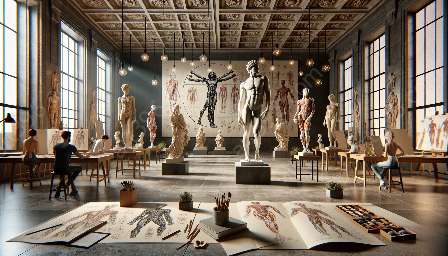Exploring the gender differences in muscular anatomy and their representation in art is a fascinating journey that unveils the intricate relationship between anatomy, artistic representation, and societal perceptions. In this comprehensive topic cluster, we delve into the complexities of understanding the muscular anatomy from a gender-specific perspective and its portrayal in art.
Understanding Artistic Anatomy
Before delving into the gender differences in muscular anatomy and its artistic representation, it's essential to understand the concept of artistic anatomy. Artistic anatomy involves the study of the human body's structure and form, focusing on how muscles, bones, and other anatomical elements interact to create a cohesive and accurate representation of the human form. Artists, especially those involved in figurative art such as sculpture, painting, and drawing, rely on their knowledge of anatomical structures to accurately depict the human body in their artworks.
Gender-Specific Muscular Anatomy
Men and women possess distinct muscular anatomies, characterized by differences in muscle mass, distribution, and strength. These differences are primarily attributed to hormonal influences, genetic factors, and physiological adaptations. For example, men generally exhibit greater muscle mass and definition, particularly in areas such as the chest, shoulders, and upper body, owing to higher levels of testosterone. Women, on the other hand, have a higher percentage of body fat and typically exhibit a more pronounced development of certain muscles such as the glutes and thighs due to estrogen and progesterone levels.
Artistic Representation of Gender Differences in Muscular Anatomy
The portrayal of gender differences in muscular anatomy in art is influenced by various factors, including cultural norms, historical perspectives, and societal ideals of beauty and strength. Artistic representations of the male form often emphasize muscularity, power, and physical prowess, reflecting traditional notions of masculinity. On the other hand, depictions of the female form in art frequently highlight aspects of softness, grace, and elegance, often downplaying muscular definition and strength.
Cultural and Societal Influences
It's important to recognize that artistic representations of gender differences in muscular anatomy are heavily influenced by cultural and societal norms. Throughout history, societal expectations and gender stereotypes have played a significant role in shaping how male and female bodies are depicted in art. These representations often reflect and reinforce prevailing attitudes towards gender roles, physical beauty standards, and societal power dynamics.
Challenging Conventions in Art
While traditional artistic representations may adhere to established gender norms, contemporary artists are increasingly challenging these conventions by creating more diverse and inclusive depictions of gender differences in muscular anatomy. Through their artworks, these artists seek to celebrate the unique characteristics of the male and female form, transcending traditional stereotypes and embracing a more nuanced and inclusive understanding of gender and anatomy.
Implications for Society
By examining the intersection of gender differences in muscular anatomy and artistic representation, we gain valuable insights into how societal perceptions of gender and the human body are reflected and perpetuated through art. This exploration prompts critical discussions about beauty standards, body image, and the evolving dynamics of gender representation in visual culture.
Conclusion
The relationship between gender differences in muscular anatomy and their artistic representation is multifaceted, encompassing biological, cultural, and artistic considerations. Understanding and appreciating the nuances of gender-specific muscular anatomy enhances our ability to interpret and create art that authentically reflects the diversity and complexity of human bodies. Moreover, it provides a platform for challenging societal norms and fostering a more inclusive and empowering visual language that celebrates the diversity of gender and anatomy.

